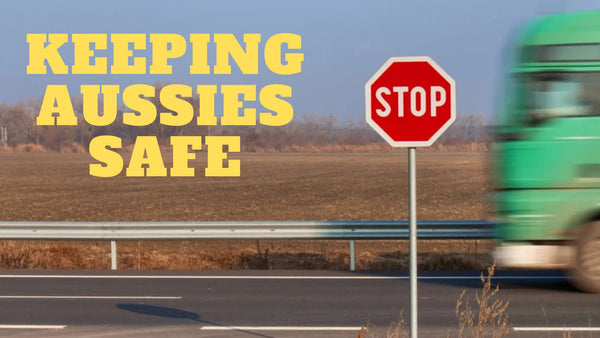Stop Signs: Keeping Australians Safe on the Road
Stop signs are a common sight on Australian roads and play a crucial role in regulating traffic flow, preventing accidents, and promoting safe driving habits.
In this article, we will explore the importance of stop signs in road safety, the design standards that ensure their effectiveness, and the proper placement of stop signs to maximize their impact.

What Are Stop Signs?
Stop signs are traffic signs that instruct drivers to come to a complete stop before proceeding.
They are recognized by their distinctive shape - a red octagon with white text in the center - and are designed to be highly visible from a distance.
Stop signs are a legal requirement in many traffic situations, including at intersections and in areas where roadworks are taking place.
Stop signs are particularly important in situations where there is a high risk of collisions, such as at busy intersections, pedestrian crossings, or in areas where there are obstructions to the driver's vision.
By requiring drivers to come to a complete stop, stop signs give drivers time to assess the situation and proceed only when it is safe to do so.
Types of Stop Signs
While the standard stop sign is the most well-known type, there are several other types of stop signs that are used in different situations.
Prohibition Signs
Prohibition signs indicate activities that are not permitted, such as turning right or left.
They use a red annulus and backslash on a white background to convey their message.
Prepare to Stop Signs
These signs warn drivers of upcoming stop signs or traffic lights.
They are designed to encourage drivers to slow down and be prepared to come to a complete stop.
Custom-Made Signs
Custom-made signs can be used in a variety of situations, such as in construction zones, areas with pedestrians or wildlife, or to warn of hazardous road conditions.
Design Standards
To ensure that stop signs are effective in promoting road safety, they must adhere to strict design standards.
These standards cover everything from the size and shape of the sign to the placement of the text and the use of reflective materials to enhance visibility.
Australian Standards 1742, AS 1743, and AS 1906 set out the design requirements for stop signs, while Australian Standard AS1319-1994 sets out the design requirements for prohibition signs, including stop signs.
These standards are regularly updated to reflect new research on the most effective ways to design and place traffic signs.
One of the key design features of stop signs is their color scheme. The red background with white text is designed to be highly visible from a distance and to convey a sense of urgency to drivers.
The shape of the stop sign - an octagon - is also distinctive and helps to differentiate it from other traffic signs.
In addition to color and shape, the placement of the text on the stop sign is also critical. The word "STOP" must be placed in the center of the sign and must be large enough to be easily read from a distance. The font used for the text must also be clear and legible.
Reflective materials are another important design feature of stop signs. These materials help to increase visibility at night or in low-light conditions.
The use of retroreflective materials, which reflect light back to its source, can be particularly effective in enhancing visibility and reducing the risk of accidents.
Importance of Adhering to Design Standards
Adhering to design standards for stop signs is critical for ensuring that they are effective in promoting road safety.
Signs that do not meet these standards may be less visible or less effective in conveying their message to drivers.
In addition to meeting design standards, it is important for stop signs to be properly maintained.
Placement of Stop Signs
Effective placement of stop signs is crucial in ensuring that drivers can see them and react accordingly.
Generally, stop signs are placed at intersections where traffic from different directions converges, but there are also other situations where stop signs may be necessary.
Some common locations where stop signs are placed include:
- Four-way intersections
- Three-way intersections
- Two-way intersections where one road has significantly more traffic than the other
- Intersections with obscured views due to trees, buildings, or other obstacles
- Intersections near schools or other areas with high pedestrian traffic
- Intersections near railway crossings
It is important that stop signs are placed in a location that is visible to drivers and provides enough time for them to come to a complete stop.
Placing a stop sign too close to the intersection can be dangerous as it does not allow enough time for drivers to come to a stop safely.
On the other hand, placing a stop sign too far away from the intersection can make it difficult for drivers to see it in time to react.
Additionally, stop signs should be placed in a location that is visible to drivers from all angles.
This means that the stop sign should be visible to drivers approaching the intersection from all directions, including those driving on side roads or turning onto the road with the stop sign.
Common mistakes in stop sign placement include:
- Placing stop signs too close to the intersection
- Placing stop signs too far away from the intersection
- Placing stop signs in areas with poor visibility or obstructed views
- Placing stop signs on a curve or at the crest of a hill
- Failing to place stop signs at all-way stops or in other situations where they are necessary for safety
It is important for local councils and road authorities to regularly review the placement of stop signs and make adjustments as necessary to ensure that they are effective in promoting road safety.
Conclusion
Stop signs are an important tool for promoting road safety in Australia. They are used to regulate traffic and prevent accidents at intersections and other areas where traffic patterns may be dangerous.
Stop signs are recognizable by their distinctive shape, color, and design, and are a legal requirement in many traffic situations.
There are several different types of stop signs, including prohibition signs and prepare-to-stop signs, each designed to convey a specific message to drivers.
Custom-made stop signs may also be used in situations where standard signs are not appropriate.
Proper design and placement of stop signs is crucial in ensuring that they are effective in promoting road safety.
Adhering to design standards such as Australian Standards 1742, AS 1743, AS 1906, and AS1319-1994 is important to ensure that stop signs are recognizable and convey the intended message to drivers.
Additionally, stop signs should be placed in locations that are visible to drivers from all angles and provide enough time for drivers to come to a complete stop.
Overall, stop signs play an important role in keeping Australians safe on the road. By understanding their purpose and following their instructions, drivers can help to prevent accidents and promote road safety for all.

